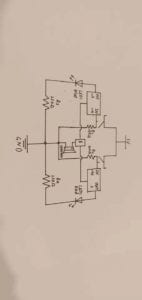Lab Time:10/11/2019
Partner:Andrew Xie
Components Used:
For Steps 1 and 2
- 1 * 42STH33-0404AC stepper motor
- 1 * L293D ic chip
- 1 * power jack
- 1 * 12 VDC power supply
- 1 * Arduino kit and its contents
For Step 3
- 2 * Laser-cut short arms
- 2 * Laser-cut long arms
- 1* Laser-cut motor holder
- 2 * 3D printed motor coupling
- 5 * Paper Fasteners
- 1 * Pen that fits the laser-cut mechanisms
- Paper
Lab Content:
- Build a controlable rotating stepper with H bridge
- Build a drawing machine with two controlable motors
Detailed Description:
Step1: Build a stepper
This step aims at building a circuit to control the stepper, using the code of Arduino>File>Examples>Stepper>stepper_oneRevolution. Below is the sketch.
This step is pretty easy because as long as you are following the instruction given, connecting the circuit right and using the right code, you can achieve this. One thing that particularly interested me is the connection of H-bridge, which needs to be built very carefully, for each of its pin has different use. And sometimes we even need to make sure that all of its pins is plugged into the breadboard.


Step1: Build a stepper
Based on the circuit of step 1, we now need to add a potentiometer into the circuit and use it to control the stepper. Because the 42sth33-0404ac Stepper Motor is a 200 step Motor, we need to make sure we’ve changed the value of variable Steps from 150 to 200. And map is needed to define the scope.


During the test there was a problem. When I was trying to make the stepper work with the potentiometer, I found the potentiometer moved much faster than the stepper. And by changing value of the variable controling the speed, I successfully solved this problem.
Step 3: Build a drawing machine with 2 steppers
The third step is simply to assemble the arm and start the stepper with a partner, but it seems that the pen is not long enough to sometimes touch the paper. It was a wonderful feeling to see the Arduino and stepper paintings.


(That’s our picture, drawn by our machine.)
Q1:
I’m interested in AI learning building. AI could be used in fields like translation or recognization, and some could even taken into art aspects. Like some AIs nowadays could restore those damaged painting and even paint by themselves.
Q2:
Comparing our work to the shadow chaser , for which the artist uses computers to control robots with the shape of metal skeletons to beat drums, and further uses robots to express human situations or emotions. And actors to enhance the robot’s performance more subtly.It’s like the stepper on reception, which can play instruments by rotating to different angles, or motor, which can support robot walking. The more complex combination of drawing machine is the work of these artists.














